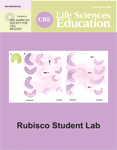BioDiversifying the Curriculum
INTRODUCTION
The conundrum of biodiversity is that there's so much of it, more species than a person can count, more interactions than a supercomputer could calculate. At the same time, this unknown quantity is getting smaller at an alarming rate. Biodiversity as a life sciences subject touches evolution, ecology, conservation biology, and environmental studies. The educational challenge is to infuse biodiversity into the curriculum while emphasizing the science and addressing common misconceptions and gaps in student knowledge about biodiversity. What is biodiversity? Why is biodiversity important? Where is biodiversity? How does it arise? In a previous review (Liu, 2005), I focused on websites that support the teaching of evolution. The websites featured in that review continue to be outstanding resources. In particular the Understanding Evolution website (http://evolution.berkeley.edu) of the Berkeley Museum of Paleontology is a dynamic website that addresses biodiversity in relation to evolution. For this review, I emphasize some of the products of evolution, systematics, communities of organisms, and the environment, rather than the underlying genetic mechanisms of evolution.
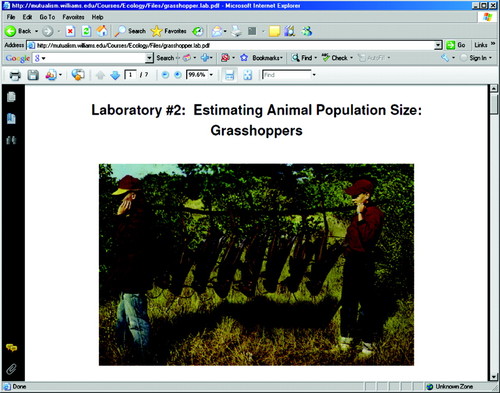
Figure 1. The Williams College website (http://mutualism.williams.edu/Courses/Ecology/Files/grasshopper.lab.pdf) has an excellent version of capture–recapture method for estimating population size.
FIELD RESEARCH AND THE BIOBLITZ
For starters, let's go outside our fluorescently lit classrooms, away from our model–organism-filled labs and into the field. I was dumbfounded when, in my first real biology class in ninth grade, Mr. Rostvold told us we were going to do fieldwork, a population study on grasshoppers. Our site was an extensive “prairie”—Midwest dialect for “empty lot”—along the train tracks right by the school. We walked there with nets and little jars of yellow paint. I had extensive prairie experience and didn't need a stinking net to catch grasshoppers, although a few of my subjects may have gotten a bit overmarked. Two days later, we returned to the site to recapture hoppers. I'm sure there was a bias in trying to recapture the painted hoppers; in any event, our population estimate was enormous. Corn farmers downstate could have told us that. The simple exercise was engaging and raised lots of good questions. What is a population? Did our estimate define a geographic population, or a breeding population? What do grasshoppers eat? How far do grasshoppers travel? I was impressed by the recapture technique and the power of simple math and statistics to respond to the impossible task of counting every member of a population. I was gratified to find many good versions of this engaging activity on the Web, geared at every educational level from grade school to college. Manuel Morales has published a good version of this activity (http://mutualism.williams.edu/Courses/Ecology/Files/grasshopper.lab.pdf) for an ecology course at Williams College (Figure 1; http://mutualism.williams.edu/Courses/Ecology/Syllabus). The capture–recapture method remains important for estimating population sizes. Examples can be found in medical research (www.phac–aspc.gc.ca/publicat/cdic-mcc/18-4/a_e.html), wildlife management (www.wii.gov.in/tigerreport/chapter3.htm), and social and health research (www.ncbi.nlm.nih.gov/pubmed/12594197).
Fieldwork is so engaging, and species so numerous, that a form of educational recreation has arisen called the bioblitz. A bioblitz convenes a group of people—neighborhood volunteers, club members, a girl scout troop, and so on—to spend a day or two combing an environment to identify as many organisms as they can find. In case you think this is the field equivalent of handouts and busy work, new species have been identified during these amateur biodiversity celebrations. In 2002, a new genus of centipede was found living in the leaf litter in Central Park in the middle of New York City! A bioblitz can focus on a city park, a national park, a river, or a neighborhood prairie. The cooperative and community nature of a bioblitz is critical to success, and the presence of experts in various arenas such as, birds, fungi, trees, insects, to name a few, is essential in driving home the point that the biota is so rich that no single expert can come close to knowing it all. A bioblitz could be a great class project. There are many websites with interesting information on bioblitz:
www.nationalgeographic.com/field/projects/bioblitz.html—National Geographic organizes bioblitz in partnership with the U.S. national parks.
http://web.uconn.edu/mnh/bioblitz—A particularly good bioblitz website from a consortium in Connecticut.
http://depts.washington.edu/natmap/bioblitz—State-of-the-art global positioning system (GPS) and species identification software are often used at a bioblitz, and the University of Washington has developed some excellent Nature Tracking software.
www.iobfs.org/fslink.html—In case you are looking for more field experience than a 1-d bioblitz, the Biological Research Stations website is a guide to research stations worldwide.
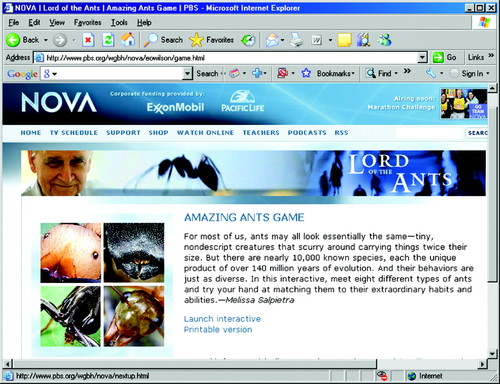
Figure 2. The webpage of the science program NOVA has a feature on the life of E.O. Wilson, the world's eminent ant scholar and proponent of biodiversity studies (www.pbs.org/wgbh/nova/eowilson).
Pulitzer Prize winner E. O. Wilson, Dean of Biodiversity, Lord of the Ants, has been a big proponent of the bioblitz as a way of engaging the public in biodiversity and instilling a sense of biophilia. The website of the PBS series NOVA has a nice feature on Wilson, associated with a TV program on his life that first aired in 2008 (Figure 2; www.pbs.org/wgbh/nova/eowilson). Dr. Wilson has authored more than 20 beautifully written and highly influential works. For scientists and science educators, Wilson's enduring masterpiece is The Diversity of Life (http://books.google.com/books?id=FzPaB_6Pw4MC, Wilson, 1992). First published in 1991, the book draws from more than 30 years of experience teaching biodiversity and evolution to Harvard undergraduates. This book has withstood the test of time as an outstanding reference and introduction to the science of biodiversity. An interview with Dr. Wilson on the Action Bioscience website (www.actionbioscience.org/biodiversity/wilson.html) summarizes some of the major points made in The Diversity of Life, but you'll miss the evocative prose. Over the decades, Dr. Wilson has increased his role as a spokesperson and advocate for biodiversity, emphasizing in particular the notion of earth as an unexplored planet with hotspots of biodiversity.
BIODIVERSITY IS NOT EVENLY DISTRIBUTED
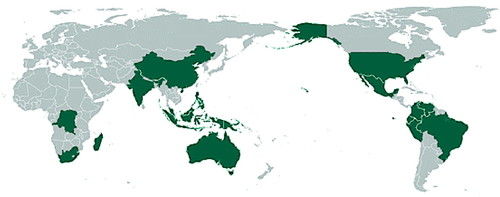
Figure 3. A map of the 17 megadiverse countries listed on the Australian Department of the Environment website (www.environment.gov.au/biodiversity/hotspots/index.html).
Biodiversity is not homogeneously distributed. For example, there are a small number of countries that are categorized as “megadiverse.” As a group, the megadiverse nations support an estimated 70% of the planet's biodiversity. Australia is a proud member of this group, and the Australian Department of the Environment, Water, Heritage and the Arts has an excellent website on biological diversity (Figure 3; www.environment.gov.au/biodiversity/hotspots/index.html). I think students will be interested to note that the United States and Mexico, for example, but not Canada, are on the megadiverse list. It's worth pondering what factors contribute to megadiversity: land area, latitude, altitude variation, amount of coastline, and freshwater volume? The Australian site also discusses the concept of biodiversity hot spots. These are locations that have high levels of biodiversity, largely intact native ecosystems, and high numbers of endemic species. Most biodiversity hot spots are in the tropics and adjacent to areas of very high human population density. E. O. Wilson is fond of pointing out how little investment it would take, $28 billion, to ensure that the world's biodiversity hot spots are kept intact—trivial amounts compared with recent government spending around the world. Wilson's estimate originates with a conference sponsored by Conservation International in 2004. Conferees concluded that a mere $4 billion would secure most of earth's tropical forest wilderness concentrated in Congo, New Guinea, and Amazonia from further logging. The remaining $24 billion would fund preservation of biodiversity hot spots estimated at ∼2.4 million square km in 25 different regions. Conservation International has an excellent website focused on biodiversity hot spots (Figure 4; www.biodiversityhotspots.org/Pages/default.aspx).
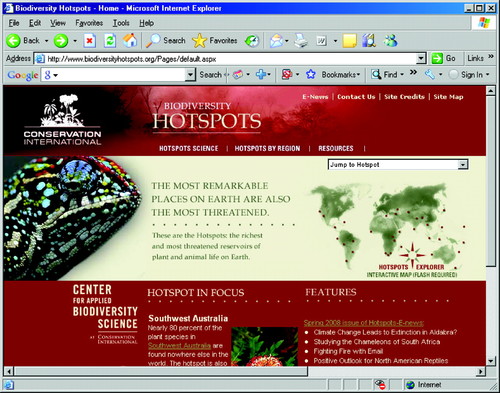
Figure 4. Conservation International has an excellent website (www.biodiversityhotspots.org/Pages/default.aspx) with information on biodiversity hotspots.
Although people worldwide are busy contributing to the degradation of their local and national environments, every nation on earth is proud of its natural heritage. There are some good websites devoted to the documentation, study, and preservation of biodiversity worldwide.
www.vivanatura.org—Viva Natura is dedicated to the biodiversity of Mexico, another member of the megadiverse nations club. Interestingly, although Australia lists 17 nations, Mexico only lists 12, leaving out South Africa, Malaysia, Papua New Guinea, the Philippines, and Venezuela. The site has some good videos and photos.
www.biodiversity–day.info—South Africa is indeed both megadiverse and home to biodiversity hot spots. In 2008, International Biodiversity Day featured South Africa, in particular celebrating the Kruger to Canyons biosphere. The website features maps and an excellent video.
www.cbin.ec.gc.ca/index.cfm?lang=e—Environment Canada has an excellent website on Canadian biodiversity, even though it is not a megadiverse country.
www.nbn.org.uk—The National Biodiversity Network of the United Kingdom is probably the best and most accessible of the nation-based biodiversity websites. That may be due to the plethora of naturalists in the United Kingdom, a place where it's said no bird can lay an egg without the time and GPS coordinates of the event being recorded by an amateur naturalist. The country is one big bioblitz.
www.nbii.gov/portal/server.pt—The National Biological Information Infrastructure (NBII) is administered by the U.S. Geological Survey (USGS). The overall organization of the homepage is clean and designed to get you to the relevant information fast. For a site with “Information Infrastructure” in its title many of the pages are actually more in the line of introductory tutorials to topics. NBII offers a good and sizable digital image library.
Clearly, there hardly could be a more global science than biodiversity, and there are a number of massive websites devoted to storing, sorting, and analyzing data on biodiversity. Until recently, these sites were primarily data repositories and were difficult places to make heads or tail fins of for a nonspecialist. In the past decade, sites such as Global Diversity Information Facility (http://data.gbif.org/welcome.htm) have been improved to make access easier to multiple taxonomic databases and to support federated searches across disparate databases. Unfortunately, most of these sites remain opaque to nonspecialists. In recognition of the more general interest in biodiversity, several worthy initiatives have evolved, and I mention two of the most prominent.
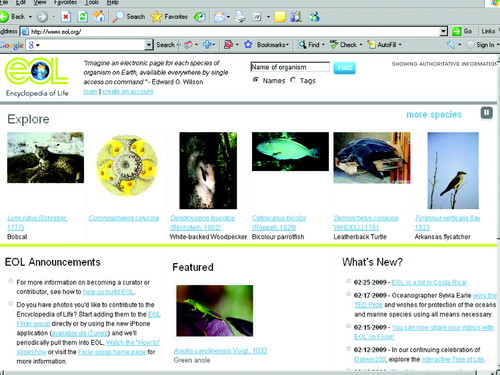
Figure 5. The Encyclopedia of Life is a massive website (www.eol.org) with the goal of creating a Web page for every species.
The Encyclopedia of Life, or EOL (Figure 5; www.eol.org) is closely associated with E. O. Wilson, who was instrumental in encouraging its development and launch. The key concept is that every species on earth get its own “page,” in other words, an extensible Web document. Toward this end, contributors use a standard template that incorporates common navigation features, and ways for serving photos, video, and text about a species or group. Interesting tools include a slider that modifies the level of content, from “authoritative” to “all,” which I found perplexing. It could be useful to have a way to filter content to individualize it to a reader's level of interest, but I had a hard time figuring out what the slider was doing. Perhaps the slider implementation is species dependent or not yet fully implemented. Curation is central to the EOL, which means its content depends on the community of experts to identify, assemble, and author content. Relying on volunteer curation necessarily means that despite shared templates, species pages will vary hugely in depth and even quality of information, but this diversity of information reflects reality. The best pages, those featured in the “Explore” bar, are very good, and the esthetics of the site are pleasing. Currently EOL is as much vision as it is reality, which is to say, lots of species are missing for now. A nested taxonomy feature facilitates browsing up or down taxonomic levels. Overall, I am enthusiastic and optimistic about the EOL. I hope in the immediate future EOL will improve search and browse capabilities, which is particularly important to reach beyond the specialist audience. I recommend viewing the orientation videos to get started.
The Tree of Life (TOL) project (http://tolweb.org/tree) was initiated several years before the EOL. At this writing, there are still more species pages on TOL than on EOL. As befits its name, TOL emphasizes phylogenetic relationships, and they have worked out a partnership with the significantly better-funded EOL to focus their efforts on phylogeny and fossil species. I think that TOL is currently ahead of EOL in the education front in supporting the ability of individuals to build custom pages. One can only hope in the long run that these two excellent efforts will evolve to be productively complementary, rather than redundant or competitive. Competition is healthy, but synergy can produce better results.
THE NESTED LEVELS OF BIODIVERSITY
Biodiversity is immense, 3–100 million species, depending on what estimation method you use, what organisms you study, and who you ask. But, biodiversity also occurs at levels that are hard to fathom. A recent paper by Julie Segre and colleagues, A Diversity Profile of the Human Skin Microbiota (Grice et al., 2008; http://genome.cshlp.org/content/18/7/1043), documents the diversity of bacteria found in the crook of your elbow. They used sequencing of 16S ribosomal subunits to identify 113 “species” of bacteria in six bacterial divisions. What is so impressive is not just that there are more species in more niches than we could have imagined but that there are so many levels of interaction and interdependence. One of my favorite examples is the work of Asher Treat in the 1960s on mites that colonize the ear of noctuid moths (http://research.yale.edu/peabody/jls/pdfs/1960s/1967/1967-21(3)169-Treat.pdf). The mites nest in moth ears, establish facilities like a nursery and a latrine, but they infest only one ear so that moths retain their ability to sense the sonar signal of predatory bats. They use a pheromone trail to ensure that only one ear is colonized. I can't help but wonder what is infesting the elbows of the mites!
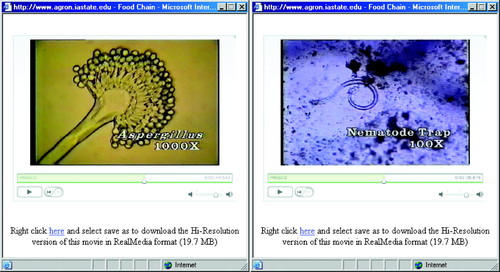
Figure 6. The Soil Biology movies website (www.agron.iastate.edu/∼loynachan/mov) by Tom Loynachan of Iowa State University has 18 short movies of life in the soil.
The soil is perhaps the most familiar and important “hidden” environment. Most students probably have a vague appreciation of soil, but few come close to realizing the diversity of life it contains. If the human inner elbow harbors 113 bacterial species, it's a good guess that the soil beats that by orders of magnitude (www.pnas.org/content/103/3/626.full.pdf+html). Estimates run in the millions for the numbers of distinct bacterial genomes in a single gram of soil (www.sciencemag.org/cgi/content/abstract/309/5739/1387?ck=nck). Studies featuring molecular methods for sampling and inferring diversity are powerful, but nothing beats seeing the actual organisms. Tom Loynachan in the Agronomy Department at Iowa State University has put together a nice collection of soil biology movies (Figure 6; www.agron.iastate.edu/∼loynachan/mov). These 18 narrated videos, each one to three minutes, feature some of the diverse inhabitants of soil, including Actinomycetes, the source for most of our medicinal antibiotics; the voracious Vorticella; and the adorable tardigrades. The U.S. Bureau of Land Management has a website devoted to soil biology communities (www.blm.gov/nstc/soil/index.html). The site contains good introductory information on the major members of the soil community including: fungi, bacteria, protazoa, nematodes, and arthropods. They have a separate, “Just For Kids,” site as well. In case you were thinking that dirt is dirt, there's the USGS soil crust website (www.soilcrust.org), devoted to the peculiar thin topsoil of the desert. There's a photo gallery and Crusts 101 introduction to soil crusts, particularly rich in cyanobacteria.
Insects account for nearly 1 million of the 1.2 million identified animal species. They are ubiquitous and in many respects overwhelmingly dominant in the soil and throughout terrestrial environments. The insect images website (www.insectimages.org) is a collaborative project of the U.S. Department of Agriculture Forest Service, University of Georgia, and the Bugwood Network. The site focuses on insects invasive and otherwise found in the United States. The site provides a good collection of photos and encourages use under a creative commons license. Among the domineering insects, one group stands out as the über-insects, and that's the ants. Antbase (http://antbase.org) is a cooperative venture of the American Museum of Natural History and The Ohio State University. The website includes an estimate of how many ant species have been identified (46,614 and counting), a list of these identified ants, and descriptions of all the ants, including photos. It's a fascinating glimpse into an important slice of the taxonomic pie.
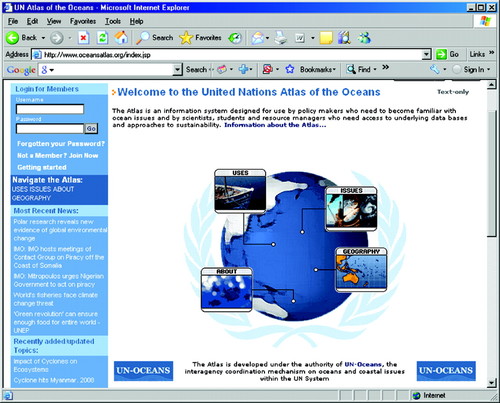
Figure 7. The United Nations Atlas of the Oceans (www.oceansatlas.org/index.jsp) has information, maps, and access to databases of information on the status of the world's oceans.
If soil is a hidden world right underfoot, then the oceans are a vast parallel universe that we've barely begun to fathom. The majority of our planet's life lives in the oceans. There are a number of excellent websites that support exploring marine biodiversity:
www.oceansatlas.org/index.jsp—United Nations Atlas of the Oceans; Figure 7.
www.coris.noaa.gov—National Oceanic and Atmospheric Administration's Coral Reef Information System.
http://scaa.usask.ca/gallery/lacalli—Marine Invertebrate Larvae. An elegant way to display photos in the context of a phylogenetic tree.
www.reefbase.org/global_database/default.aspx?section=r5—A biodiversity database designed to facilitate exploring data on the world's coral reefs.
http://seamounts.sdsc.edu—Seamounts online is a site devoted to the world's submerged peaks, unique ocean environments associated with high biodiversity.
http://earthguide.ucsd.edu—Earthguide from The Scripps Institution of Oceanography has images, maps, and interactive features on the ocean.
www.iobis.org—Ocean Biogeographic Information System census of marine life is primarily a search engine that covers >500 databases. Searching those databases takes time, many seconds, but the results are interesting, allowing a user to look at information on a given species that draws from disparate sources.
www.rzuser.uni-heidelberg.de/∼bu6/index.html—Marine Flatworms of the World is a site primarily devoted to polyclad flatworms, but there's also a section on nudibranch molluscs. Lots of nice photos.
www.ciesm.org/online/atlas/index.htm—Exotic species in the Mediterranean is a very interesting, well-written, and well-designed site. It serves as an important reminder that exotic and invasive species can threaten endemic biodiversity and degrade an environment in less obvious ways. Click on the various lists and then access excellent information pages on various organisms.
www.cmarz.org/procedures/policy_on_use–dna_data.htm—Census of marine zooplankton is a DNA barcoding project. There are numerous barcoding projects, but this website is of interest because of its focus on plankton, perhaps not as charismatic as sea mammals but more fundamental in the food chain.
Although they are far from hidden, given that we are practically surrounded by the vascular plants, they are often unjustly taken for granted. Here are several good websites concerned with plant biodiversity:
www.bgci.org—The Botanic Gardens Conservation International website has a wealth of resources for plant enthusiasts and those interested in conservation. The “Major Threats to Plant Diversity” section (www.bgci.org/global/threats) has excellent information.
http://rainforests.mongabay.com—A conservation focused website that has particularly good information on rain forests biodiversity.
http://botany.csdl.tamu.edu/FLORA/gallery.htm—The Vascular Plant image library is a huge site of plant images organized by family.
http://ddc.hampshire.edu/simforest—Forest Simulator from Hampshire College is free downloadable software for Mac or PC. Students can plant trees, change soil conditions, and monitor forest succession. The site also has curriculum for K–12 and college.
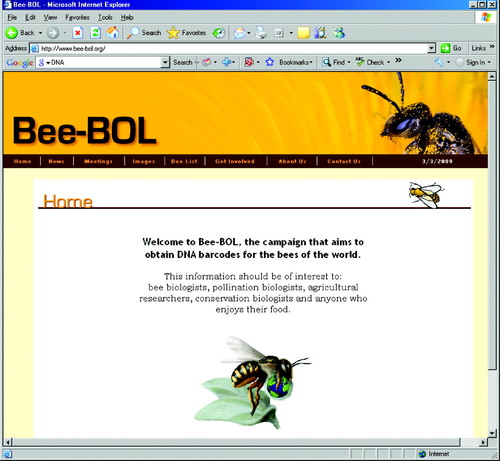
Figure 8. Bee-BOL is one of the projects of the Consortium for the Barcode of Life project (www.barcoding.si.edu), aimed at using DNA sequence to identify species.
CODIFYING LIFE'S DIVERSITY
I've not directly addressed the issue of how organisms are identified, classified, and named. It may surprise some to know that the controversy over using molecular methods for classification still simmers. There is little dispute that DNA sequence is a useful tool for classifying organisms. The discussion lies in the extent to which DNA sequence constitutes a gold standard for classification. To quote an eminent ant biologist off the record, “Beware the barcode zealots, they think all you need is a barcode, no natural history, no fieldwork, no analysis of characteristics. What use is a barcode if you don't know anything else about an organism?” I did not sense much of such zealotry while looking at the various websites for barcoding projects, such as the previously mentioned zooplankton barcoding project. However, it is important to resist the seductive trap of thinking that once you have a barcode, that's another species in the database, job done, let's move on. Enthusiasm for the simple concept of just getting a DNA barcode for every species is an understandable response to the seemingly impossible task of identifying every species on the planet, but clearly we need more information than just DNA sequences.
The concept of a DNA barcode is appealing and easy to understand, although there are important nuances and details for a student to explore. Barcoding is an excellent opportunity for bringing biodiversity into courses that emphasize molecular biology. The barcode concept bridges classical taxonomy and molecular genetics. A good place to get an introduction to the concept and current prevalent method for DNA-barcoding is the website of The Consortium for the Barcode of Life, hosted by the Smithsonian Institution (Figure 8; www.barcoding.si.edu). The term “barcode” in this case is of course being used as a grocery store metaphor to evoke the notion that a sequence of DNA can be used to identify, not a unique individual, but a unique species. You can immediately see that identifying a species is tricky when there are disputes and uncertainty over what constitutes a species, particularly for prokaryotes and plants. And surely, sequence differences between individuals must distribute along a smooth gradient from near identical to highly divergent, without clear breaks to delineate species, genus, family etc. It's important to discuss with students the spectrum of information one would want to know about a putative species, including a barcode sequence. Exploring the challenge in defining DNA sequences that would be informative for differentiating members of one species from another could be very educational for students. At this time a region at the 5′ end of the cytochrome C oxidase subunit 1 (CO1) mitochondrial region has emerged as the standard barcode region for many groups of animals. Also referred to as the Folmer region, the 5′ end of CO1 is 648 nucleotide base pairs in most groups and flanked by regions of conserved sequences that facilitate isolation and sequencing. Teachers and their students could make a list of pros and cons in using the Folmer region for identifying unique species and then compare the list to the information they find from an array of experts in the field. To give you a single example, the CO1 sequence is excellent for most fish, but not for cichlids, a group that has experienced a very rapid, recent radiation.
To view actual barcode data go to www.barcodinglife.org/views/login.php, the Barcode of Life Data Systems pages. A prominent box lists the number of formally described species with barcodes, 50,374 as of this writing, and the total number of barcode records, 528,808; depending on the species estimates you subscribe to the collection needs several million, tens of millions, or hundreds of millions of species to collect a full barcode registry. The site has some very useful research tools that can be adapted to education uses including a taxonomy browser, Identify Specimen feature, and Introductory Tutorial. The introductory tutorial is excellent, an animation of narrated screen shots to orient you to the concept and software workflow for obtaining, accessioning, and managing barcode data. I particularly like the Taxonomy browser because it organizes information by taxonomic group with pie charts and physical distribution maps. Under “Resources,” there is a series of presentations formatted as pdfs and as PowerPoint presentations that offer introductions to DNA barcoding that could be adapted to classroom presentation. The National Center for Biotechnology Information has a good tutorial on barcoding. The shockwave tutorial is introduced with some good, basic informational text. You will need Flash version 10 to view the tutorial. (www.ncbi.nlm.nih.gov/bookshelf/br.fcgi?book=coffeebrk&part=Mtcoffeebreak#Mtcoffeebreak.EXTYLES.7)
It's also worth looking at some case studies of DNA Barcoding (www.bolinfonet.org/casestudy). The case study website is meant to facilitate community building and to encourage researchers to join the effort. You can view recent submissions, which are one-page abstracts on a particular project, or you can browse the larger collection. I browsed by taxonomic group, chose mollusks, and found some interesting cases. One case study involves the Turrinae, a poorly described group of venomous mollusks in the same family as the cone snails, the Conoidea. Reading these case studies could give students a realistic feel for the difficulties that taxonomists face, for the challenges of fieldwork in general, and for the value of combining information from the field with information from the lab.
As I alluded to earlier, the CO1 region of the mitochondrial genome does not help in species identification for all taxonomic groups. The land plants are one such important group. Fortunately, researchers have been minding this gap and seem to have a solution for plants, the matK locus (www.sciencedaily.com/releases/2008/02/080205111733.htm). Researchers of the Royal Botanic Gardens, Kew, have been leading the effort and have a website devoted to DNA barcoding and their project for plants (www.kew.org/barcoding). Click on “Phase 2 Update” to see the loci that they have been focusing on.
Because I've focused on DNA barcodes, I want to close this section by listing the leading Nomenclature groups. These “commissions” essentially have the power to recognize or reject the identification of a new species and to approve names that follow their set standards. Such commissions have been in operation long before the dawn of the molecular era, and they represent the collective, if sometimes bureaucratic, wisdom of generations of skilled taxonomists:
www.iczn.org—International Commission on Zoological Nomenclature.
http://ibot.sav.sk/icbn/main.htm—International Code of Botanical Nomenclature.
www.ncbi.nlm.nih.gov/books/bv.fcgi?indexed=google&rid=icnb.TOC—International Code of Nomenclature of Bacteria.
www.ICTVonline.org/index.asp?bhcp=1—International Committee on the Taxonomy of Viruses.
HOW MUCH BIODIVERSITY DO WE NEED?
E. O. Wilson points out in The Diversity Life that we would not exist in the absence of biodiversity. We are a product of biodiversity and Homo sapiens are not fundamental to the biosphere. We are at the top of the food and resource pyramid, wholly dependent on communities of creatures largely invisible to us. We need nature, but nature does not need our particular species. On the contrary, H. sapiens is destroying the very biodiversity that supports its own existence. It is important to develop and support with scientific evidence assertions about the need for biodiversity. An excellent place to start for a perspective on the broad value of biodiversity to humanity is the recent book Sustaining Life edited by Eric Chivian and Aaron Bernstein (Chivian and Bernstein, 2008) of Harvard Medical School's Center for Health and the Global Environment. The Center has a website in support of the book (http://chge.med.harvard.edu/programs/bio/index.html). The book treats in detail the four major ways that humanity depends on biodiversity, for medicines, for ecological services (e.g., clean water), for basic biomedical research, and for food. There are also chapters on various threats to biodiversity and an excellent section on the most threatened groups of organisms most important to medical research, which may influence some lay people more directly. The website presents the table of contents for the book. Eric Chivian reports that several colleges and universities are adopting the book as a text for undergraduate courses (Chivian, personal communication, September 2008). A section of the website, “Interviews and Lecture Videos,” contains video- and audio-only recordings. The Smithsonian Institution National Museum of Natural History helped launch the book in May 2008, and the video recordings are an opportunity to hear E. O. Wilson and Eric Chivian discuss biodiversity. Part 1 shows their presentations, and part 2 documents questions and general discussion from the audience. The files are big enough that you could consider showing them in class, but they are not chaptered, so they are tedious to screen and cue to select portions. Eric Chivian's lecture to an audience at the Museum of Science in Boston is a good introduction to the book and its issues. For a concise version of the arguments from Sustaining Life, visit the Nature Serve website (www.natureserve.org/index.jsp), an organization devoted to connecting science and conservation. They list 10 excellent reasons to save biodiversity (www.natureserve.org/consIssues/tenReasons.jsp). Green facts on biodiversity (www.greenfacts.org/en/global-biodiversity-outlook) is another good website to explore why we need biodiversity and how it's threatened.
Growing numbers of people are convinced that something needs to be done to save the planet's biodiversity, resulting in many websites where students can go to learn more and find ways to get involved:
www.panda.org/news_facts/publications/living_planet_report—WWF–living planet report and living planet index.
www.unep-wcmc.org/climate—United Nations world conservation monitoring center.
www.bgci.org/resources/news/0339—Botanic Gardens Conservation International, Botanic Gardens site focused on plant documentation and conservation; good maps.
www.greenfacts.org/en/global-biodiversity-outlook—Green Facts on Biodiversity. I like this website's approach of three levels, fast facts, details, and source documents. The site is tilted toward policy rather than science but emphasizes data including graphs and tables.
http://animaldiversity.ummz.umich.edu/site/index.html—An animal diversity website from the University of Michigan Museum of Zoology emphasizes the familiar animals and is a good way to introduce younger students to biodiversity. The bird section, for example has good pictures, museum specimen photos, and audio files of bird calls.
www.biodiversity.wa.gov/education/index.html—A biodiversity website for Washington State that includes curricula and citizen science pages. Perhaps the most useful part for K–12 teachers is the correlation of biodiversity curricula to state and national educational standards.
http://info.globio.org/educators/lag.htm—Globio is aimed at elementary science and consists primarily of an encyclopedia and glossary. Learning activity guides are connected to specific articles and linked to National Science Teachers Association standards. Topics include Wetlands, Tropical Rain Forest, Conservation, Temperate Rain Forest, Environments, Mangroves, and Earth Day.
www.earthscope.com—Earthscope is based on nonconventional ways of mapping created originally by Buckminster Fuller of buckyball fame. The website features interactive maps and narrated slide shows that are engaging for the general public, and perhaps high school-level science.
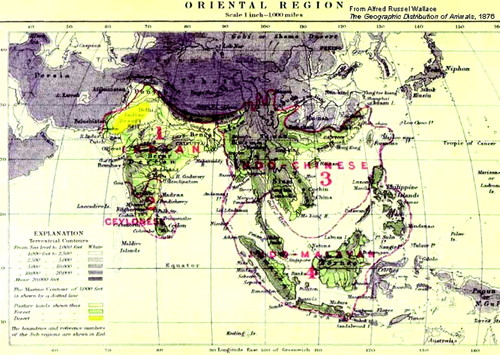
Figure 9. A map showing The Wallace Line in red, from the University of California, Berkeley, evolution Web pages (http://evolution.berkeley.edu/evosite/history/biogeography.shtml).
BIOGEOGRAPHY
I'd like to close with a short section on biogeography. Long before the term biodiversity was coined, there was biogeography, concerned with the geographical distribution of species, how those distributions change over time, and elucidation of the factors that influence species distributions. Biogeography has a long history as an academic discipline that has become somewhat removed from the popular culture dimensions of biodiversity. However, biogeographers should receive their due credit. In this year of Darwin celebrations, it's particularly fitting to recognize the founder of biogeography, Alfred Russell Wallace. The Berkeley evolution website has a good page on Wallace, including a discussion of the Wallace line, the most famous biogeographical line in history (Figure 9; http://evolution.berkeley.edu/evosite/history/biogeography.shtml). The Alfred Russell Wallace website is a labor of love by Wallace enthusiast George Beccaloni (http://wallacefund.info), and it is full of interesting information on Wallace, his writings, and ideas.
Here are some other outstanding biogeography websites:
www.biogeography.org/html/Resources/index.html—The International Biogeography Society website is a good place to learn more about the profession.
www.wku.edu/∼smithch/biogeog—Early classics in biogeography to 1950 is a bibliography and full-text archive of papers and books on biogeography.
www.biogeomancer.org—Biogeomancer is a mapping project to support biodiversity, software, and standards for georeferencing.
www.biogeog.ucsb.edu—Biogeography lab University of California, Santa Barbara, is a good site for a view of a working lab devoted to ecological mapping studies in California.
www.nyu.edu/projects/fitch/courses/evolution/html/biogeography.html#—This page offers an interesting view of how an instructor at New York University organizes his courses in biogeography and evolution.
http://bss.sfsu.edu/geog/bholzman/courses/fall99projects/ armadillo.htm—Alhough narrow in scope, the biogeography of the nine-banded armadillo presents a fascinating species.
ACKNOWLEDGMENTS
I Thank Malcolm A. Campbell for many helpful comments on this manuscript. I also encourage readers to e-mail me at [email protected] with suggestions for future topics.


